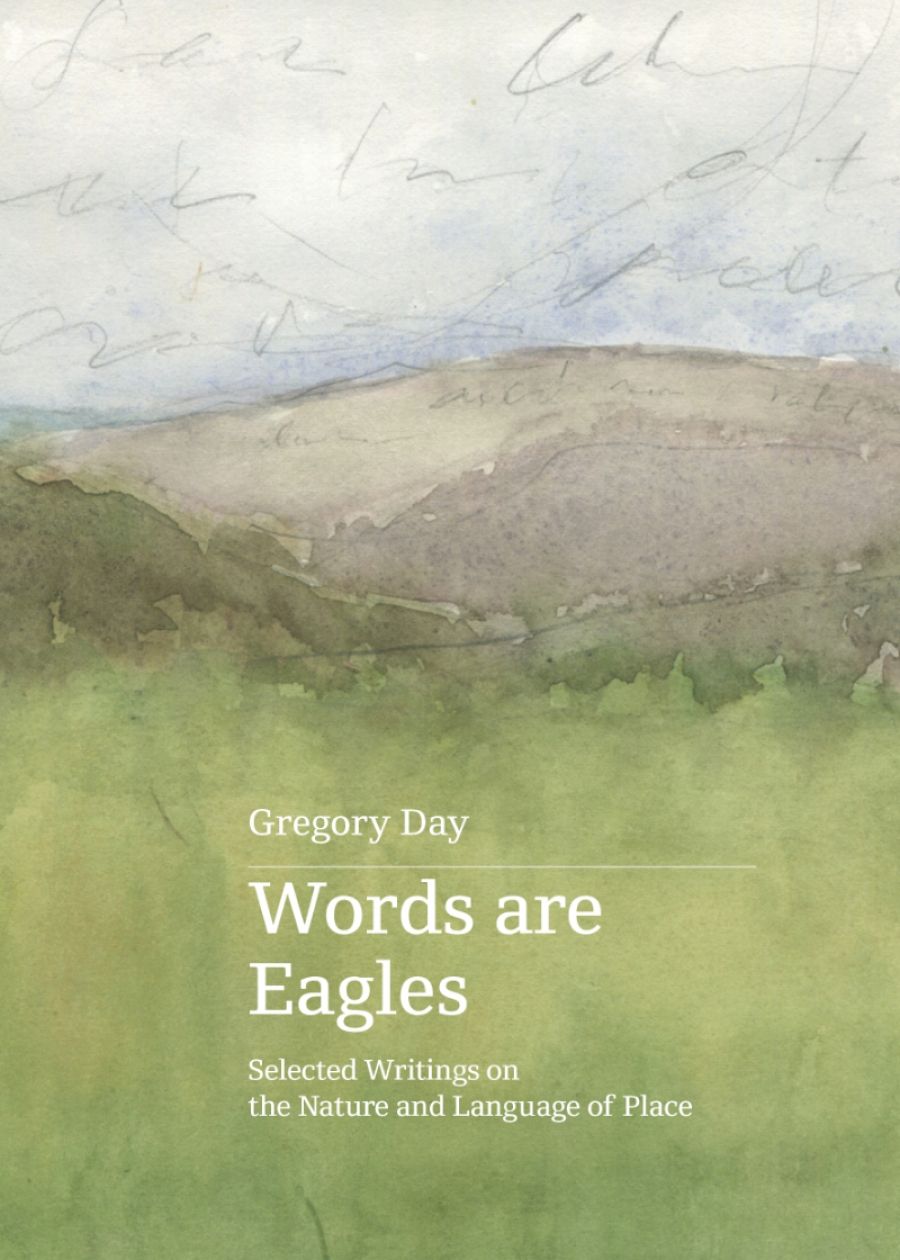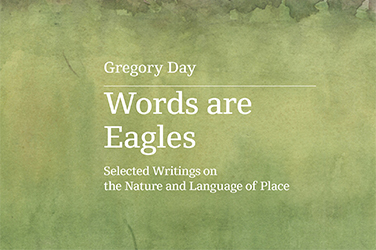
- Free Article: No
- Contents Category: Nature Writing
- Review Article: Yes
- Article Title: Word ecology
- Article Subtitle: Plumbing the mystery of inheritance
- Online Only: No
- Custom Highlight Text:
Across Australia today, exciting work is being done to strengthen and renew Aboriginal languages and their deep associations with Country. In those parts of the continent where the history of dispossession has been most traumatic, language regeneration calls for research and reconstruction, for the rediscovery of the old words for places, features, and life itself. Gregory Day’s new book is a distinguished and discerning quest for the lore and language of his beloved place.
- Article Hero Image (920px wide):
%20crop%20copy.jpg)
- Article Hero Image Caption: Gregory Day (Image: Supplied)
- Alt Tag (Article Hero Image): Gregory Day (Image: Supplied)
- Featured Image (400px * 250px):

- Alt Tag (Featured Image): Tom Griffiths reviews 'Words Are Eagles: Selected writings on the nature and language of place' by Gregory Day
- Book 1 Title: Words Are Eagles
- Book 1 Subtitle: Selected writings on the nature and language of place
- Book 1 Biblio: Upswell, $29.99 pb, 288 pp
- Book 1 Readings Link: booktopia.kh4ffx.net/5b34k1
Day’s home is Mangowak (Aireys Inlet) which sits in Wadawurrung Country on Victoria’s western coast between basalt plains and southern surf, under the beam of the Split Point lighthouse and looking south-west to the Otway ranges plunging into the sea. The author’s ancestry is Irish and Sicilian; his great-great-grandparents on both sides found their way to this region about the same time in the 1840s. Day honours this cultural inheritance, but also examines the consequences of being ‘born of the conquerors’, as Judith Wright put it: the responsibilities of living on land with a history of violence, dispossession, and dire loss of people and knowledge. He writes that the broken song and awful absence along this western Victorian coast ‘always [sit] near the core of my work’. The reference to ‘broken song’ is not accidental: Day shares many interests with his fellow poet of the southern shore, Barry Hill.
Day draws his book title from a novel, Strandloper, by the English writer Alan Garner about William Buckley, the English convict who, in 1803, escaped the colonial settlement at Sorrento and spent thirty-two years living with the Wadawurrung. Garner imagines an elder called Nullamboin coming upon Buckley cutting words with a stick in sand and finding him willing even to write out the name of Bunjil, the revered and powerful wedge-tailed eagle. Nullamboin is shocked that knowledge might be transferred in such a casual, unritualised way. ‘Then all will see without knowledge,’ he cries, ‘without teaching, without dying into life! Weak men will sing! Boys will have eagles! All shall be mad!’
That ideas of sacred power might be disembodied, displaced, and transferred by anyone, and just by writing, does seem a path to disorder and madness (think of the internet). How, then, might one recover and reconstruct not only the original words but also their origins in landscape, ecology, and history, thus restoring their true authority? Day’s writing is driven by a hunger for local knowledge and a discriminating sense of place, and also by a thirst for the renewal of ecological integrity and restoration of balance to the land. He knows this will be a long, slow process and that understanding ‘how the sound of a place enters our speech’ is essential to that quest.
The book is in three parts. The first weaves its way sensuously into Mangowak and makes the case for local language learning. As a musician, poet, and novelist paying attention to birds and animals, river and ocean, Day spent some years teaching Wadawurrung words at the local primary school attended by his children. The opening essay of this section, ‘The Watergaw’, deservedly won the Nature Conservancy Nature Writing Prize for 2021 (don’t miss Day’s beautiful reading of it, with music and soundscape, on the Griffith Review website). With delicacy and poetic power, it tells of the sighting over Inverleigh of a watergaw, the broken shaft of a rainbow, which, in Day’s essay, is made to stand for ‘broken blood, broken words, broken land, broken bodies’, smashed-up colonial ground. ‘The Watergaw’ is also a poem by the Scottish poet Hugh MacDiarmid who ‘fished deeply in old Scots’ seeking a truer language of his place, even changing his own name from Christopher Grieve. Day’s essay, which is also a reading of the poem, resonates between northern and southern hemispheres, between Old and New Worlds (whichever is which), thus introducing Day’s double inheritance.
Part two of the book, ‘The Ocean Last Night’, continues the journey into the author’s country and expands the search for sound by immersing itself in the Otways’ ocean, attending to its resonant depths. The land may have been silenced by the invasion, ‘but the ocean was a radio’. We hear the story of a middle-aged man who, in 1937, arrived alone at the Grand Pacific Hotel on the coast at Lorne and took a high, front room for a week. Recently widowed, he was sent there by friends who felt he needed a break from grief and single parenting – and during that week he learned that the sound of the sea under his pillow was the most beautiful sound on earth. That man was the author’s grandfather whom he was never to meet – but the transformative sonic influence of the sea was passed down through the generations, becoming an anchoring song in the ear of his descendants who expect to hear the ocean each night. This is the other central essay of a book that hums, pulsates, and echoes with the music of nature and the languages that grow from it – and that plumbs the mysteries of inheritance.
The third and final part is a series of book reviews that mostly continue the mission of the book by exploring the literature of nature and place writing, north and south. Perceptive assessments of Australian nature writers such as Alec Chisholm, Harry Saddler, George Seddon, and Tim Flannery nestle productively beside readings of the British, European, and American authors Robert Macfarlane, Kathleen Jamie, John Stilgoe, Richard Jefferies, Sarah Orne Jewett, Tove Jansson, and others. Day shares much with Macfarlane: both are lyrical writers making pilgrimages who are fascinated by the revival of lost or suppressed languages that attend to the particularity of places. Macfarlane’s celebration in Landmarks of a Peat Glossary from the outer Hebridean island of Lewis is a companion to Day’s meditation on 133 different recorded spellings of ‘Wadawurrung’. Day relates to the aesthetics of northern-hemisphere nature writing but grapples more urgently with ethics in Australia, where ‘violent dispossessions push hard on the heels as soon as one begins even to think of writing about its landscape’.
This third section also includes subtle readings of poets John Kinsella, Judith Beveridge, Robert Adamson, and the ever-present Seamus Heaney, and these are a delight. But some of the reviews anthologised here (for example, about Patrick Modiano, Colm Tóibín, A. Frances Johnson, and Eleanor Clayton on the sculptor Barbara Hepworth) don’t fit so well with the drive of the essays. Their inclusion makes the volume more of a collection and less of a book.
I relished reading and re-reading Words Are Eagles, and keenly appreciated its poetic mysteries, philosophical playfulness, and powerful evocation of a region. It beautifully captures (and seeks to accelerate) a significant shift in Australian culture towards respecting and re-learning the language of nature and place: the ecology of words that belong here.


Comments powered by CComment